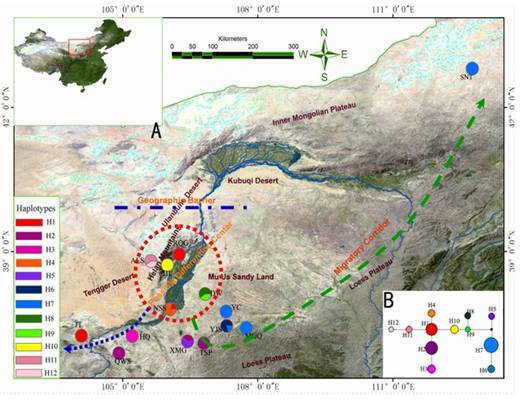Phylogeography of Lagochilus ilicifolius (Lamiaceae) in Relation to Quaternary Climatic Oscillation and Aridification in Northern China
2011-10-28
To the present, most studies on phylogeography of plants in China have focused on the endangered or endemic species, and have especially concentrated on species located in the Hengduan Mountains, on the southeast of the Qinghai-Tibetan Plateau, due to its high level of species and genetic richness. As a result, few studies have been carried out regarding evolutionary history of species adapted to the arid lands distributed in regions of higher latitude in China.
The natural vegetation of northern China is dominated by steppes, with a relatively homogeneous environment. However, studies on phylogeography have most often been directed at woody plants, and have focused on a few endemics and characteristic components of the mountainous cool-temperate conifer and deciduous forests of this region. Herbaceous plants might have been more sensitive to Quaternary climatic oscillations than woody plants, because of their short life cycles, and would therefore be ideal candidates to illustrate the evolutionary history of the flora. However, there is some lack of knowledge about phylogeographical studies have ever been conducted on herbaceous plants of the northernmost part of China.
Therefore, MENG Honghu and Prof. ZHANG Mingli, used an integration of molecular data with paleoclimatic and paleogeologic methods to examine the phylogeographical patterns of Lagochilus ilicifolius, a perennial herb belonging to the family Lamiaceae, ranging from northern China to parts of Mongolia and Russia. They investigated variability in sequence of two chloroplast cpDNA spacers in samples of natural populations of L. ilicifolius with 168 individuals from 14 populations. The purposes of this study were to characterize: (1) the genetic structure of L. ilicifolius populations in this area according to cpDNA sequence variation; (2) the phylogeographical pattern and demography, to determine how these were affected by desert expansion associated with climate changes of the late Quaternary.
In this research, they inferred the population structure and history of L. ilicifolius by using nested clade analysis, neutrality tests, divergence time estimates, and mismatch distribution analysis, and also identified twelve haplotypes. Genetic differentiation among populations within groups was also elevated (FSC 0.772), suggesting restricted gene flow among populations within groups. Divergence time was at approximately 0.71 Ma, consistent with aridification and desert expansion during the middle Pleistocene. The Helan Mountains contained a large proportion of the haplotypes, which implies that the region may be the center of diversification for the species, whereas the Loess Plateau as a dispersal corridor for postglacial re-colonization northward. Climatic oscillation, aridification, and desert expansion within these regions have molded current distribution and biodiversity of L. ilicifolius. Their findings demonstrate that deserts are very dynamic ecosystems, with expansion and vicariance, often provide opportunities for shifts in genetic signature and evolutionary trajectory among organisms of these regions.
This work has been published on Biochemical Systematics and Ecology, 2011, 39(4-6): 787-796. It can be link from: http://www.sciencedirect.com/science/article/pii/S030519781100158X.

Geographical distribution and genealogical relationships of the 12 cpDNA haplotypes recovered from Lagochilus ilicifolius populations from northern China. (A) Pie charts reflect the frequency of occurrence of each haplotype in each population. Haplotype colors correspond to those shown in panel (B). (B) Medianjoining network linking the 12 haplotypes. Haplotypes are designated by numbers, and circle sizes are proportional to haplotype frequencies.



